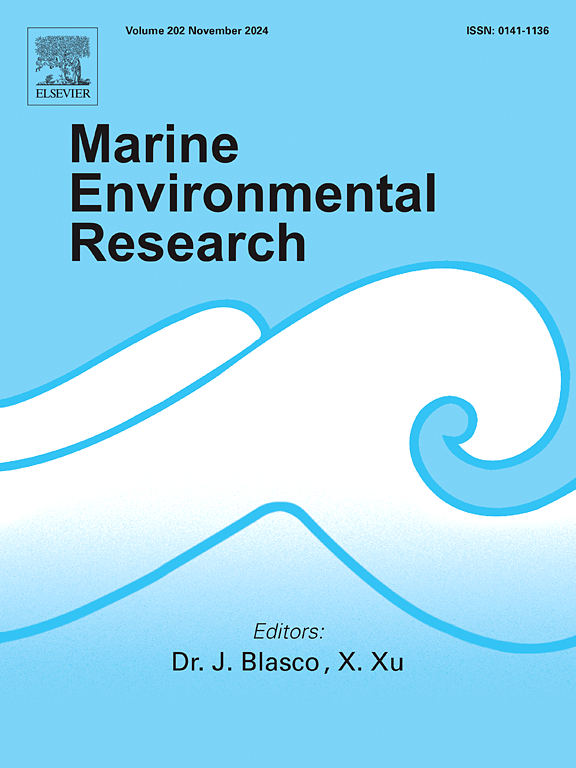Occurrence, source, and ecological impacts of dry depositing aerosol metal elements in the Bohai Bay
IF 3
3区 环境科学与生态学
Q2 ENVIRONMENTAL SCIENCES
引用次数: 0
Abstract
Bohai Bay, characterized as a typical semi-enclosed bay, has experienced substantial anthropogenic influence. Significant quantities of metal elements have been deposited into Bohai Bay through atmospheric dry deposition. This study focuses on the collection of aerosol samples during the summer and autumn of 2020 to investigate the spatial-temporal distribution and dry deposition fluxes of nine metal elements. The sources of these elements and their potential ecological effects were explored. Subsequently, the potential ecological risk posed by TSP (total suspended particulates)-bound heavy metals over the Bohai Bay was assessed. The mean concentrations of TSP-bound Cr, Cu, Zn, As, Cd, Pb, Mn, Fe, and Al during both seasons were found to be 17.84, 19.91, 205.95, 14.62, 1.12, 30.50, 32.78, 506.63, and 2054.63 ng/m3, respectively. Enrichment factors and correlation analysis suggested that Al and Fe in aerosols were primarily derived from soil dust, while other metal elements predominantly originated from anthropogenic activities. The potential pollution sources were identified primarily from the Bohai Bay coast and Mongolia. Despite the significant impact of dissolved metal elements on marine ecosystems, the study highlights the relatively serious pollution levels of Cd and As in TSP, as indicated by the Geo-accumulation index and potential ecological risk evaluation. Although the overall contribution of atmospheric deposition to inputs to Bohai Bay is relatively modest, inputs of specific metallic elements from atmospheric deposition cannot be ignored. Consequently, the dry deposition of aerosol metal elements significantly influences the biogeochemical cycling of metallic elements, providing organisms not only with nutrients but also with toxic substances.
渤海湾干沉降气溶胶金属元素的发生、来源及生态影响
渤海湾是典型的半封闭海湾,受人类活动的影响较大。大量的金属元素通过大气干沉降进入渤海湾。本研究以2020年夏秋两季的气溶胶样品采集为研究对象,研究了9种金属元素的时空分布和干沉降通量。探讨了这些元素的来源及其潜在的生态效应。在此基础上,评价了总悬浮颗粒物(TSP)结合重金属对渤海湾地区的潜在生态风险。两季tsp结合的Cr、Cu、Zn、As、Cd、Pb、Mn、Fe和Al的平均浓度分别为17.84、19.91、205.95、14.62、1.12、30.50、32.78、506.63和2054.63 ng/m3。富集因子和相关分析表明,气溶胶中的Al和Fe主要来源于土壤粉尘,其他金属元素主要来源于人为活动。潜在污染源主要来自渤海湾沿岸和蒙古。尽管溶解金属元素对海洋生态系统的影响显著,但从地质累积指数和潜在生态风险评价来看,TSP中Cd和As的污染程度相对较严重。虽然大气沉降对渤海湾投入量的总体贡献相对较小,但大气沉降中特定金属元素的投入量不容忽视。因此,气溶胶金属元素的干沉降显著影响金属元素的生物地球化学循环,不仅为生物体提供营养物质,也为生物体提供有毒物质。
本文章由计算机程序翻译,如有差异,请以英文原文为准。
求助全文
约1分钟内获得全文
求助全文
来源期刊

Marine environmental research
环境科学-毒理学
CiteScore
5.90
自引率
3.00%
发文量
217
审稿时长
46 days
期刊介绍:
Marine Environmental Research publishes original research papers on chemical, physical, and biological interactions in the oceans and coastal waters. The journal serves as a forum for new information on biology, chemistry, and toxicology and syntheses that advance understanding of marine environmental processes.
Submission of multidisciplinary studies is encouraged. Studies that utilize experimental approaches to clarify the roles of anthropogenic and natural causes of changes in marine ecosystems are especially welcome, as are those studies that represent new developments of a theoretical or conceptual aspect of marine science. All papers published in this journal are reviewed by qualified peers prior to acceptance and publication. Examples of topics considered to be appropriate for the journal include, but are not limited to, the following:
– The extent, persistence, and consequences of change and the recovery from such change in natural marine systems
– The biochemical, physiological, and ecological consequences of contaminants to marine organisms and ecosystems
– The biogeochemistry of naturally occurring and anthropogenic substances
– Models that describe and predict the above processes
– Monitoring studies, to the extent that their results provide new information on functional processes
– Methodological papers describing improved quantitative techniques for the marine sciences.
 求助内容:
求助内容: 应助结果提醒方式:
应助结果提醒方式:


